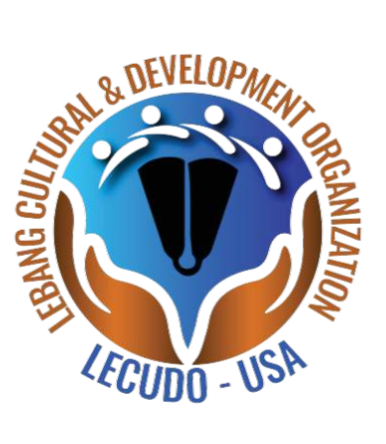By Carl-Winston
Inspired by the legacy of Kamwa Simo and the oral-textile tradition of the Bamiléké people of Cameroon
In the heart of Cameroon’s Grassland region, in a village called Baham, a centuries-old craft continues to breathe life into the fabric of identity: Ndop. More than just indigo-dyed cotton stitched with ancestral precision, Ndop is a sacred textile that embodies the spiritual, political, and artistic legacy of the Bamiléké people. It is a cloth that does not merely dress the body—it wraps memory, unites the living and the dead, and dignifies the wearer with the silent language of symbols.
A Textile That Unifies a People
In Bamiléké culture, one often hears the powerful phrase: “On est ensemble!” (“We are together!”). This spirit of solidarity is embodied in Ndop’s very creation. From cotton grown in the northern regions of Cameroon, to the weaving at the borderlands of the Bénoué River, to the intricate tying and indigo dyeing in Garoua, and finally back to the Grassland for unveiling—the journey of each cloth mirrors a national pilgrimage. Each stage involves numerous artisans, from women binding with raffia thread to master dyers and drawers of sacred motifs. It is a generational choreography that links north and south, men and women, itinerants and sedentary villagers, nobles and commoners, the visible and the invisible.
As Joël Raffier notes, Ndop is not simply a fabric—it is a unifier. It links justice to fertility, tradition to modernity, the circle to the square, the spiritual to the ceremonial. Its widespread democratization has not diluted its power. Rather, it has magnified it, making Ndop a canvas for ancestral memory in a contemporary world.
Kamwa Simo: The Blue Hands of a Nation
The legacy of Ndop is personified in the life of Kamwa Simo, a master artisan born around 1925 in Baham. Sent to the royal palace at 14 as a valet under King Kamwa Mars, he was drawn not to courtly status but to art. In secret, he trained under Guemdjo Elisabeth (known as mafeu), daughter of the king and an artist herself. Upon discovering his hidden passion, the king gifted Kamwa a sewing machine—still used today in his atelier.
Known across western Cameroon as a guardian of Ndop’s sacred geometries, especially the panther motif (a symbol of royalty), Kamwa Simo transformed his family concession into a school, workshop, and sanctuary for transmission. Even in sleep, he dreamt of his hands tracing designs on unbleached cotton. “If we all die, Ndop will vanish,” his son Victor said, echoing his father’s call. So, from the age of seven, each child in the family is taught to draw, dye, and understand the sacred weight of this cloth.
The Language of White and Blue
In Victor Tadjuidje’s words, “White represents nature. Look at the sky—it is white in one direction, and blue in the other.” This intuitive connection between sky and cloth, nature and geometry, animates the designs on Ndop. The motifs—zoological, human, and cosmic—are not just aesthetic. They are mnemonic, totemic, and protective. In Bamiléké cosmology, the body has two forms: the visible and the invisible. Just as the Ndop cloth hides its whiteness until the final stage of binding and dyeing, so too does every human carry a hidden essence.
These “white dots” are not decorative; they guide, protect, and remember. During colonization, when spiritual protections were stripped and chiefs were hunted, Bamiléké communities turned again to their sacred cloth—to reclaim their double, their dignity, their spiritual lineage.
Ndop: Historical Production Process
-
Cotton cultivation and spinning in northern Cameroon by local farmers.
-
Weaving by artisans living along the Nigerian border, near the Benue River.
-
Sewing fabric strips known as “Leppi” or “Gabaga” and transporting them to Garoua.
-
Transporting the undyed fabric to the Bamiléké region.
-
Drawing sacred Ndop motifs on the fabric by skilled artisans using special ink.
-
Binding the patterns with raffia thread by women, following the traced designs.
-
Returning the cloth to Garoua for the dyeing phase.
-
Dyeing the fabric in indigo vats and leaving it to dry.
-
Returning the dyed fabric to the Grassland region.
-
Removing the raffia bindings, revealing the intricate white patterns on the deep blue cloth.
A Textile of Sovereigns
Historically, Ndop was reserved for royals and initiated members of spiritual societies. The sacred rites associated with the cloth conferred legitimacy and protection. In the colonial era, such textiles became targets—burned, looted, or outlawed. Yet, Ndop survived, passed in silence, worn in rituals, buried with the dead, and revived by masters like Kamwa Simo.
In Baham, his family’s home is described as a temple of fabric, echoing with the footsteps of elders, children, and totems. The cemented courtyard and bamboo-faced atelier stand not just as a house, but as a cultural archive.
The Cloth That Remembers
Today, Ndop is more than heritage—it is resistance. It is the visual memory of a people, a silent guardian of names, lands, and lineages. Whether worn by dignitaries, resurrected by contemporary designers, or celebrated at festivals, it remains a cloth that teaches us to walk forward while looking backward.
To wear Ndop is to declare: “I am of this land. I carry its past. I weave its future.”
Sources: Eyewitness interviews with Kamwa Simo and Victor Tadjuidje, translation and synthesis of the “Ndop” article by Ly Dumas, Espace Culturel Gacha archives, and oral histories of the Bamiléké.




